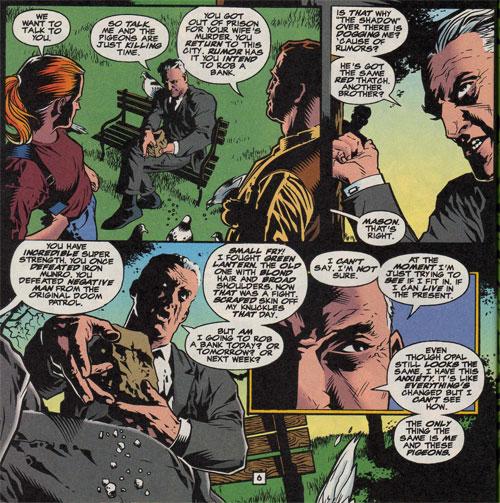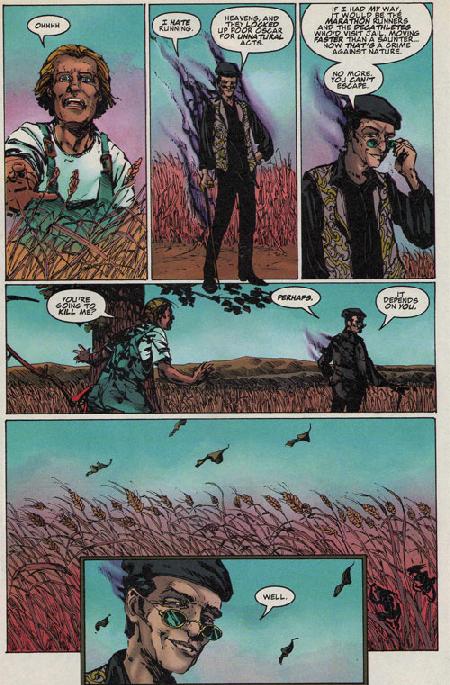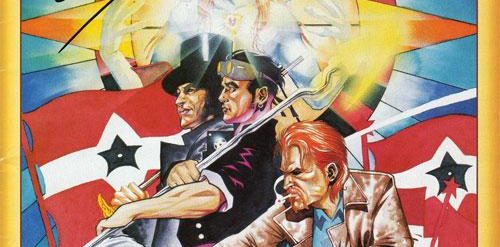Previously, in Comics 101: It’s been all Starman, all the time around these parts in recent weeks, as we’ve turned our attention to James Robinson and Tony Harris’ landmark 1990s legacy hero, Jack Knight. At about two years into the series, the book was really hitting its stride. Let’s get back to it, shall we?
STARMAN’s second year kicked off with an odd little supernatural story arc entitled “Demon Quest,” which involved Jack and the O’Dares attempting to rescue the Shade and Matt O’Dare from an otherdimensional netherworld, having been sucked in through a mystical poster controlled by a necromancer whose life force depended on luring innocents into it. Eventually, Jack himself dives into the poster to try and bring Shade and Matt home:

Separately, Jack, Matt and the Shade all encounter a demon, who appears to them as a figure from their past, with occasionally heartbreaking results. The look on Jack’s face when he’s made to remember his last visit with his mother is wrenching; it’s a brilliant piece of storytelling by Harris, the emotion he’s able to invest in the expression:

Jack, Shade and Matt unwittingly defeat the demon though, of all things, simple nobility, and earn not only their freedom, but the freedom of the hundreds of souls that had been sucked into the poster over the centuries. The result: a sudden spike in the population of the Opal, a city that had always treasured its past, and now had some living examples of it in residence.

Jack’s extended family gathers at the O’Dare home for Christmas in STARMAN #27, followed up by another Times Past issue, this time going back to 1976, and a tale of Mikaal Tomaas in the age of disco, engaging in a final drug-soaked battle with his old enemy Komak, now sporting a Freddy Mercury mustache and dying from as sexually transmitted disease.

By April of 1997, positive critical buzz around STARMAN had increased to the point that DC decided to give the series a big promotional push, with merchandise, miniseries, the whole magilla. The center of the campaign was STARMAN #29, which opened up with a 7-page prose piece from “The Shade’s Journal” (text pieces like this, first in which the Shade would opine about Opal City and its protectors through history, and later consisting of a long serialized novel about the Shade’s adventure’s in 1930s Hollywood, appeared periodically in place of the letters column, usually every third month or so), catching up new readers on Jack’s story, his now-large cast of supporting characters, and what had happened in the series so far.

The feature story, “The Return of Bobo,” introduced yet another colorful resident of the Opal, Jake “Bobo” Benetti, an old-time supervillain (albeit a plainclothes one, despite his superhuman strength) who had tangled with Jack’s father back in the day, and was returning to town after a long prison stint, unsure whether he wanted to return to the life or not.

The issue also drops another bombshell, in a letter from the Mist to Jack: while Jack lay unconscious in the Mist’s lair during the events of “Sins of the Child,” Nash had taken advantage of him, and the result of their encounter was their newborn son, Kyle:

As for Bobo Bennetti, not seeing much of a future for himself out in the real world, he elects to rob an Opal City bank, only to find himself beaten to the punch by visiting supervillains the Royal Flush Gang. When Jack shows up expecting to face Bobo, the two team up and wipe the floor with the Royal Flush Gang, sharing an unexpected male-bonding moment in the midst of the chaos:

Bobo winds up with a full-time gig with the bank protecting its branches all over Opal, as Jack explains to his girlfriend at issue’s end? Girlfriend? Yeah, that’s what readers were saying, too. We’ll get back to that one a little later.
Also making its debut as part of the renewed STARMAN promotion was THE SHADE, a four-issue miniseries from James Robinson and a quartet of great artists.

While the initial expectation might be that the series would shed some light on the Shade’s mysterious origins, Robinson instead elected to go in an entirely new direction, telling the story of the Shade’s century-long blood feud with the Ludlows, an British family of killers and thieves that had intended to use the temporarily amnesiac Shade as a patsy for their latest bit of murderous larceny, only to be killed by the Shade when he remembers the existence of his powers, as gruesomely illustrated by the marvelous Gene Ha.

Only the youngest Ludlows remain at the end of the Shade’s killing spree, and they swear a blood oath to gain revenge upon the killer of their family, if not by they themselves, then their children, or their children’s children.
The second issue, with art by PROMETHEA’s J.H. Williams, begins to detail the various assaults on the Shade down the years from members of the Ludlow family, and in particular the Shade’s heartbreak when his newfound love reveals herself to be a Ludlow as well, after delivering to him a dose of deadly poison (also foreshadowing a bit of romantic betrayal that would come to Jack Knight as well in future issues, though of a different kind).

Issue #3 concerns itself with the Shade’s Silver Age days as a supervillain and his frequent clashes with the Flash of Keystone City, Jay Garrick, superheroic battles that the Shade quite enjoys. When Jay Garrick elects to retire in the 1950s, a new hero, an archer calling himself “the Spider.” emerges from obscurity to take his place. He’s met with the adoration of the public, but with some suspicion by the Shade, who elects to investigate and discovers that the Spider has a criminal past. He decides to locate his former foe Jay Garrick and inform his of his successor’s misdeeds, but, in a poignant moment courtesy of illustrator Bret Blevins, finds himself unable to do so:

Shade confronts the Spider himself, only to discover even more disturbing news: he’s a Ludlow.

The series concludes in the present, with the Shade meeting up with the last remaining Ludlow, not on the field of battle, but in a field of wheat owned by farmer Craig Ludlow, whose wife had contacted the Shade when Craig’s brother resurfaced and began fanning the flames of familial hate. Shade dispatches the brother, and talks things out with Craig, in a quiet, contemplative issue illustrated by Michael Zulli.

And like most things Robinson did, it set up threads that would be picked up again years later. THE SHADE was never collected in a trade, so it may take some searching to locate a set, but it’s well worth it.
Along with the SHADE series, DC released a number of other items in their big STARMAN marketing push that year. There was a nice STARMAN t-shirt that I was never able to find, as I recall, along with two other items that were particularly cool.

First up, in a move that somewhat anticipated their later line of prop replicas, was the Starman Badge, a really cool little piece that was the spitting image of the one Jack sports, and which I have to admit I wore on my black leather jacket for a good two or three years.

Also released was this gorgeous Starman wristwatch. This I absolutely loved.

I went through two different wristbands on it, then accidentally cracked the faceplate and had that replaced, at which point my girlfriend had the good sense to recommend buying a spare if I ever saw one again, just in case someday it was beyond repair. Which I promptly did. They’re nearly impossible to find these days.
And no, you can’t have one of mine.


Comments are closed.